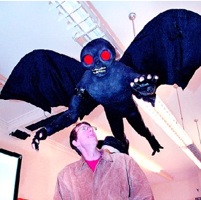Cryptozoology museums

Cryptozoology museums: "David Pescovitz: At Cryptomundo, Loren Coleman surveys several cryptozoology museums throughout the world. From the post:
Artist John Frick of Cumberland, Maryland, stands under his creation, a Mothman replica that hangs from the ceiling of the Mothman Museum in Point Pleasant, West Virginia...
What cryptozoology and Bigfoot museums would you recommend to other Cryptomundo readers from your journeys and readings? (please post comments at Cryptomundo--ed.)
Link"
Wikipedia entry on "Mothman" contains good info:
Mothman was the name given to a strange creature sighted many times in the Point Pleasant area of West Virginia, on the border with Ohio between November 1966 and November 1967. Some observers described the creature as a man-sized beast with wings and large reflective red eyes, while others claimed that the creature possessed luminous eyes. A number of hypotheses have been put forward to explain what people reported, ranging from paranormal phenomena to owls, but no definitive explanation seems likely at this time.
[...]
Analysis
1976 British edition of The Mothman Prophecies.
Enlarge
1976 British edition of The Mothman Prophecies.
There are several theories for what the Mothman phenomena involved.
The largest collection of material about Mothman is found in John Keel's 1975 book The Mothman Prophecies, in which Keel lays out the chronology of Mothman and what he claims to be related parapsychological events in the area, including UFO activity, Men in Black encounters, poltergeist activity, and the December 15, 1967, collapse of the Silver Bridge across the Ohio River. The book was the basis of a 2002 movie starring Richard Gere, directed by Mark Pellington.
Loren Coleman, in the 2002 book Mothman and Other Curious Encounters (focusing on the details of cryptozoology investigations), acknowledges Keel's "demonological" approach. Coleman first wrote about "winged weirdies" in articles and his 1978 book, Creatures of the Outer Edge.
Some of the explanations given for Spring Heeled Jack, which was sighted during the Victorian era in England, may possibly also be applied to the Mothman.
Skeptics have argued (notably in the March/April 2002 issue of the magazine Skeptical Inquirer) that the most likely explanation of the sightings is excited eyewitnesses mistaking a barn owl.
Some have argued that the most likely candidate, however, is the Great Horned Owl, since West Virginia is home to the biggest variety of great horned owls in the world. This secretive, nocturnal bird can walk upright on the ground, which gives it an uncanny resemblance to a child-sized, gray, fuzzy creature with wings that spread to up to five feet wide. The Great Grey Owl, a rare winter visitor to the lower forty-eight states, is even larger than the great horned owl, and could possibly have been the figure behind some of the mothman sightings. Another possibility is the misidentification of tall, gray sandhill crane. Seeing either a sandhill crane or a great grey owl in West Virginia would be a rare, but by no means impossible, experience.
While it is plausible that some witnesses might have misidentified a large bird, this hypothesis may have its flaws: owls do not have enormous red eyes set in their chests and do not fly at high speed without flapping their wings.
Mark A. Hall in his book Thunderbirds disputes the owl theory, but instead suggests a giant cryptid owl species, allegedly seen in the area for over 100 years.



0 Comments:
Post a Comment
<< Home